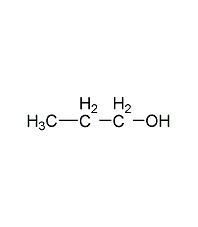
Structural formula
| Business number | 01GD |
|---|---|
| Molecular formula | C3H8O |
| Molecular weight | 60.10 |
| label |
n-Propanol, n-Propanol, n-Propyl alcohol, Optional, AlcoholC3, Propylic alcohol, thinner, dental detergent, pesticides, fungicides, antifreeze, adhesive, paint solvents, alcohol compounds |
Numbering system
CAS number:71-23-8
MDL number:MFCD00002941
EINECS number:200-746-9
RTECS number:UH8225000
BRN number:1098242
PubChem number:24856894
Physical property data
1. Properties: colorless liquid with mellow smell. [1]
2. Melting point (℃): -127[2]
3. Boiling point (℃): 97.1[3]
4. Relative density (water = 1): 0.80[4]
5. Relative vapor Density (air=1): 2.1[5]
6. Saturated vapor pressure (kPa): 2.0 (20℃)[6]
7. Heat of combustion (kJ/mol): -2021.3[7]
8. Critical temperature (℃): 263.6[8]
9. Critical pressure (MPa): 5.17[9]
10. Octanol/water partition coefficient: 0.25 [10]
11. Flash point (℃): 15[11]
12. Ignition temperature (℃): 371 [12]
13. Explosion upper limit (%): 13.5[13]
14. Explosion lower limit (%) : 2.1[14]
15. Solubility: Miscible with water, miscible with most organic solvents such as ethanol and ether. [15]
16. Viscosity (mPa·s, 20ºC): 2.26
17. Heat of evaporation (KJ/kg, b.p.): 680.8
18. Heat of fusion (KJ/mol): 5.20
19. Heat of formation (KJ/mol): -300.9
20. Specific heat capacity (KJ/( kg·K), 20ºC, constant pressure): 2.45
21. Boiling point rising constant: 1.59
22. Conductivity (S/m, 18ºC): 9.17×10-9
23. Thermal conductivity (W/(m·K), 20ºC): 1.7166
24. Volume expansion coefficient (K– 1, 20ºC): 0.00107
25. Relative density (25℃, 4℃): 0.7998
26. Refractive index at room temperature (n25): 1.3837
27. Critical density (g·cm-3): 0.276
28. Critical volume (cm3·mol-1): 218
29. Critical compression factor: 0.252
30. Eccentricity factor: 0.628
31. Lennard-Jones parameter (A): 8.361
32. Lennard-Jones parameter (K): 223.0
33. Solubility parameter (J·cm– 3)0.5: 24.557
34. van der Waals area (cm2·mol-1 ): 6.280×109
3day_100622/201006221621592746.gif” alt=”” />
4. Propionaldehyde is obtained through oxo synthesis of ethylene, and then n-propanol is obtained after hydrogenation. Alternatively, metal carbonyl compounds are used as catalysts to synthesize ethylene from ethylene. It can directly generate n-propanol with water. It can also be produced by liquid phase oxidation using propane or butane as raw material.

5. The reaction formula of the methanol method is as follows:
![]()
6. The reaction formula of vinyl carbonylation method is as follows:
![]()
7. Use industrial n-propanol as raw material, first add bromine (1.5ml of bromine water per liter of n-propanol), After mixing evenly, crudely evaporate once, add a small amount of potassium carbonate to the crude product for distillation, take the middle fraction, add a desiccant for dehydration, and finally distill the middle fraction, which is the pure product.
Purpose
1. Propanol is used directly as a solvent or to synthesize propyl acetate. It is used in coating solvents, printing inks, cosmetics, etc. It is used in the production of n-propylamine, an intermediate for medicines and pesticides, and in the production of feed additives, synthetic flavors, etc. Propanol is used in the pharmaceutical industry to produce probenecid, sodium valproate, erythromycin, epileptic acid, adhesive hemostatic agent BCA, propylthiamine, dipropyl 2,5-pyridinedicarboxylate, etc.; Various esters synthesized from propanol are used in many aspects such as food additives, plasticizers, spices, etc. Derivatives of n-propanol, especially di-n-propylamine, have many applications in medicine and pesticide production, and are used to produce pesticide aminesulfonate. Lingmao, Diprofen, Propyrrolidone, Trimethonol, Sulfonalin, Trifluralin, etc.
2. Used as a solvent for vegetable oils, natural rubber and resins, some synthetic resins, ethyl cellulose, and polyvinyl butyral. It is also used in nitrocellulose spray paint, coatings, cosmetics, dental detergents, insecticides, fungicides, inks, plastics, antifreeze, adhesives, etc.
3. Generally used as solvent. It can be used as coating solvents, printing inks, cosmetics, etc., as an intermediate in the production of medicines and pesticides, and as an intermediate in the production of feed additives, synthetic flavors, etc. Propanol is widely used in the pharmaceutical industry, food additives, plasticizers, spices and many other aspects.
4. Used as solvent and used in pharmaceuticals, paints and cosmetics, etc. [25]



 微信扫一扫打赏
微信扫一扫打赏
